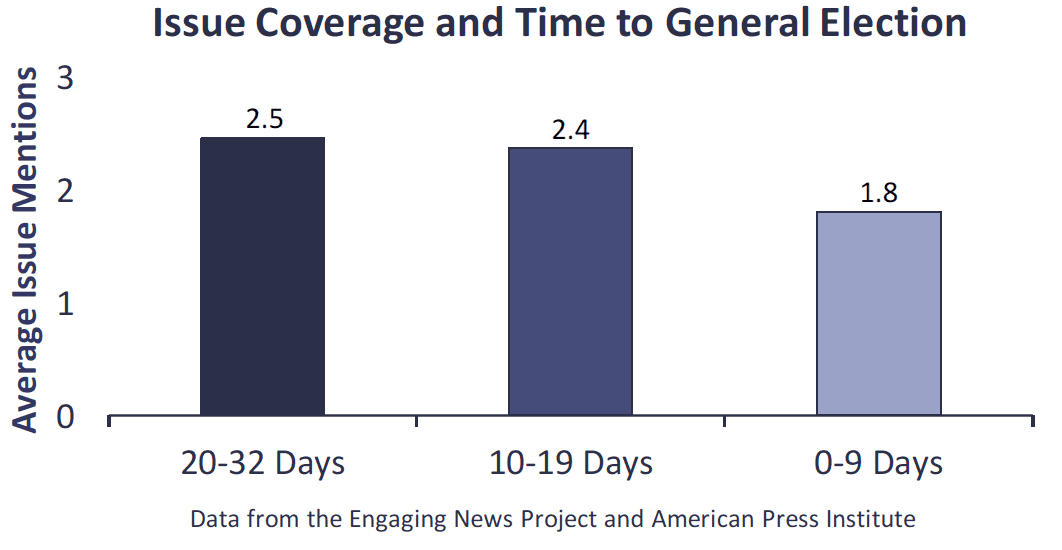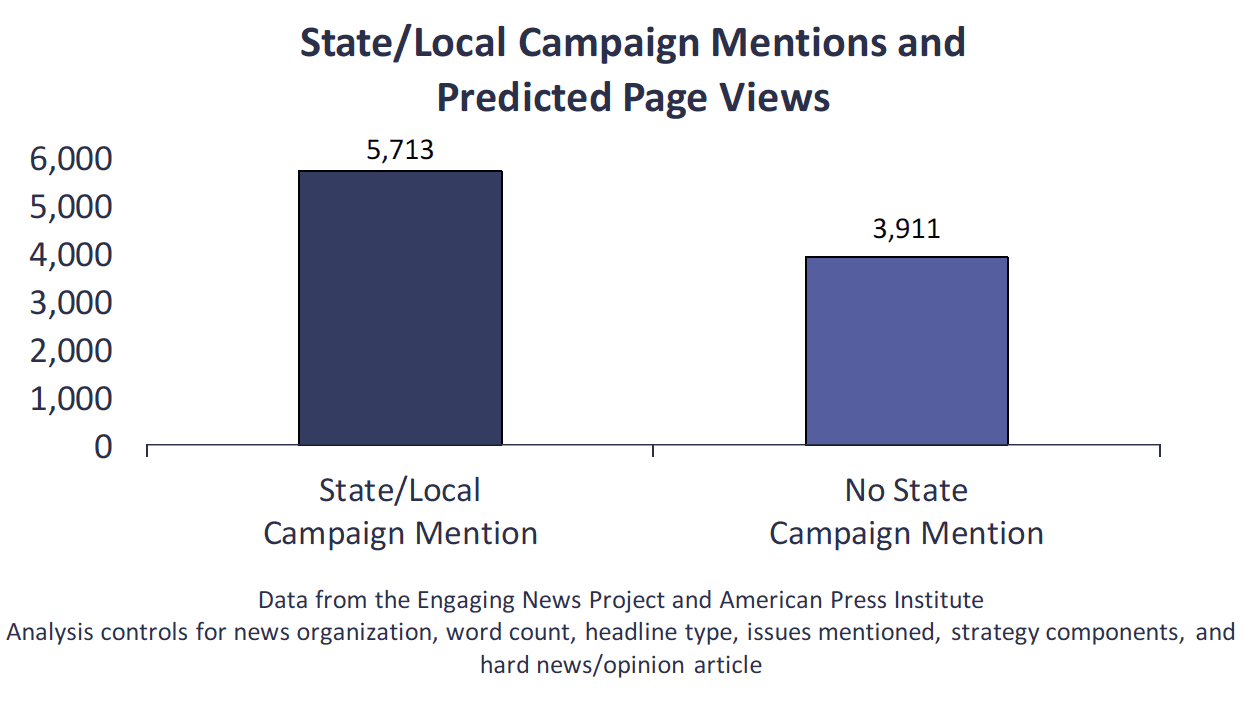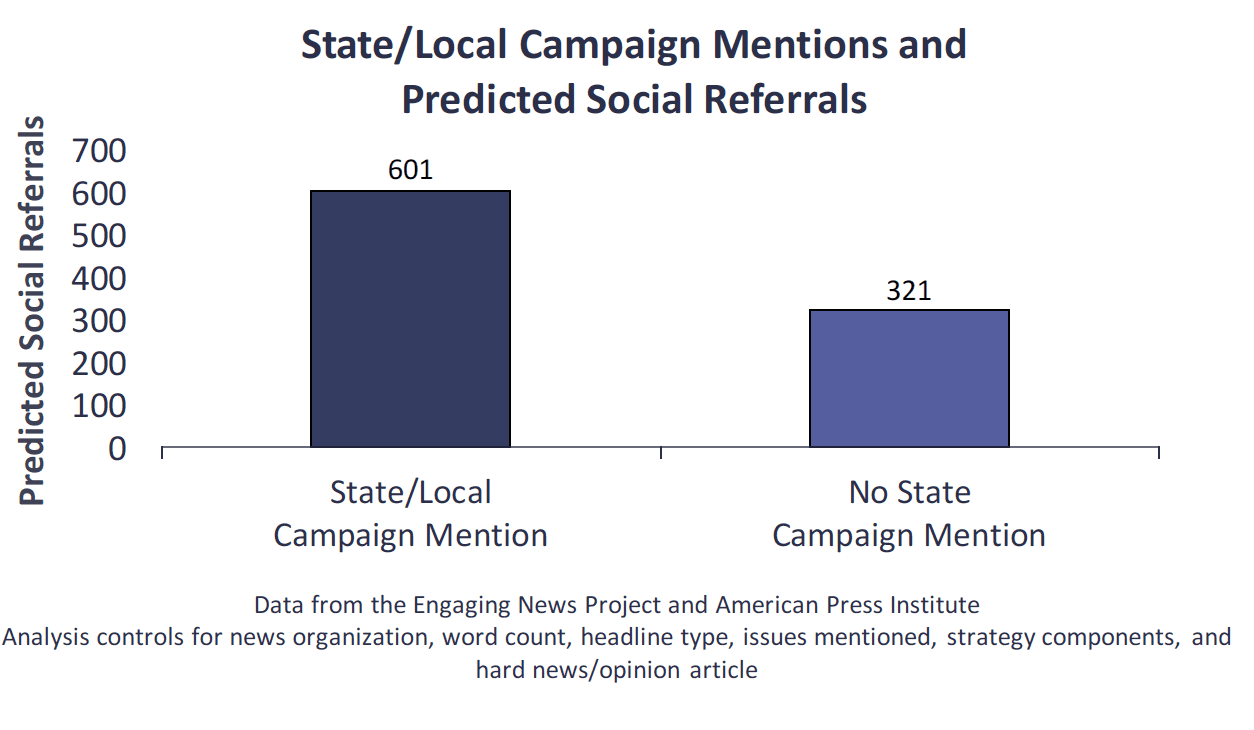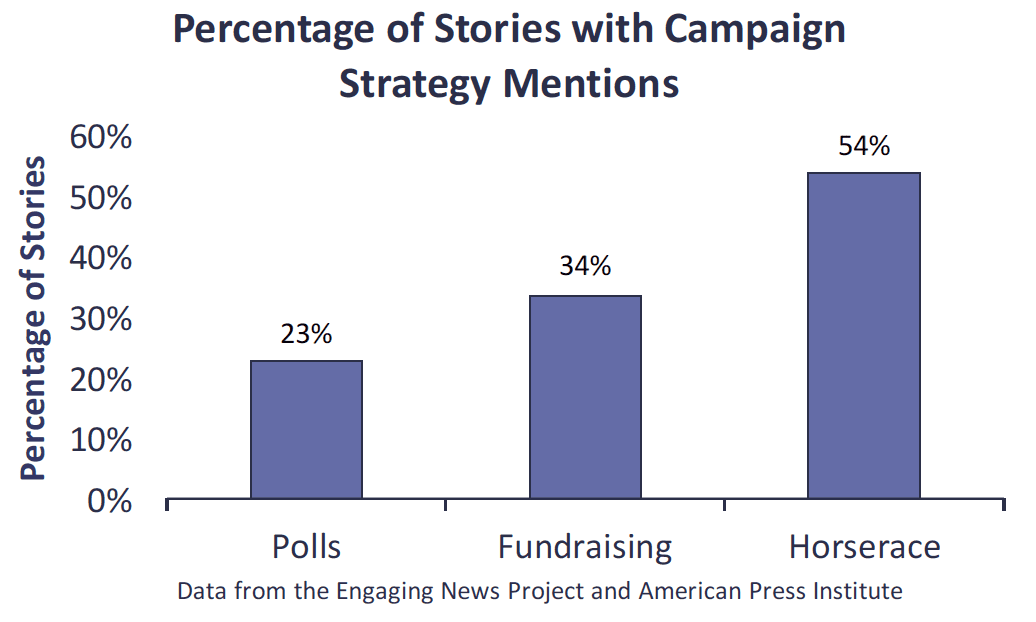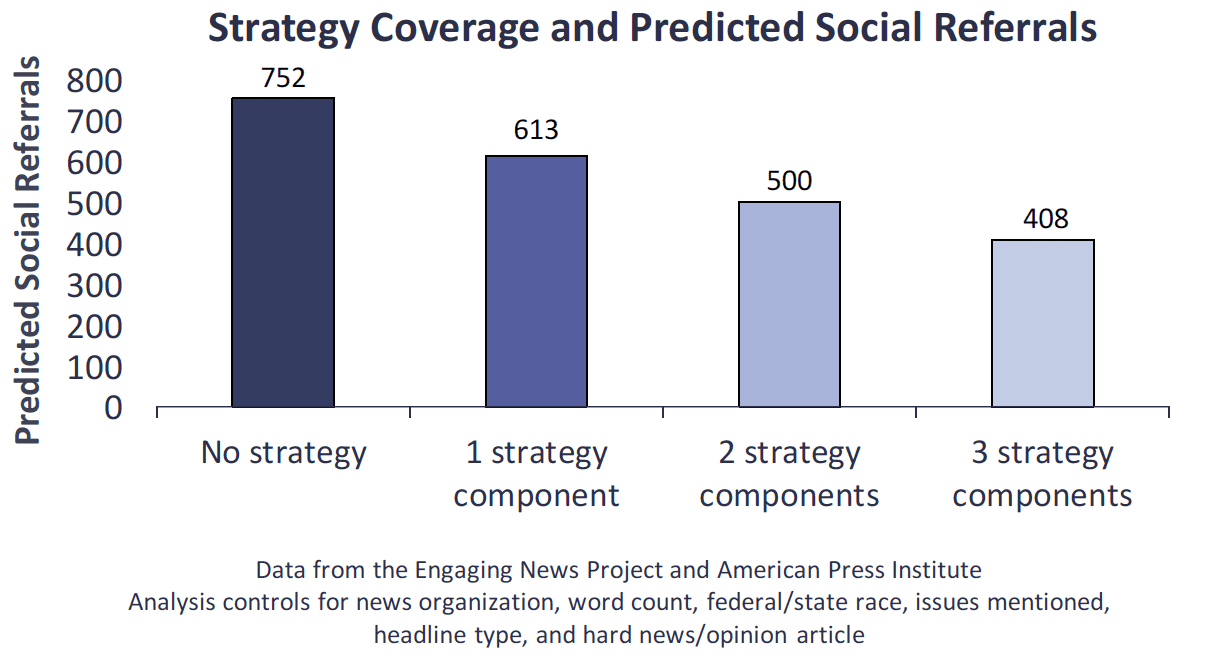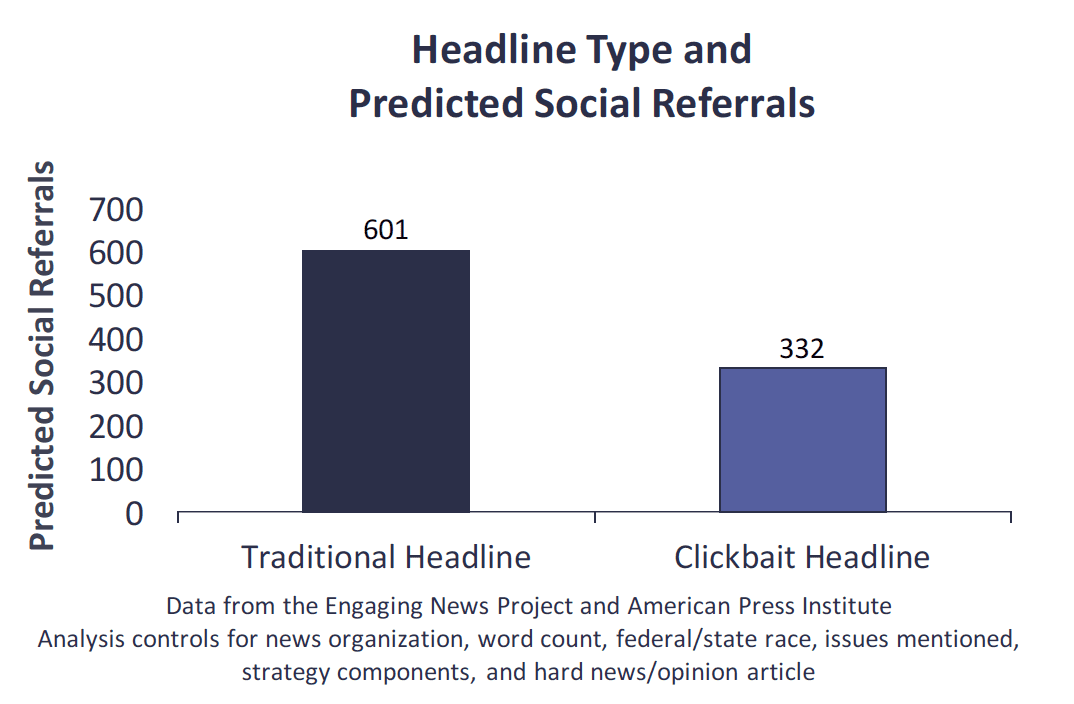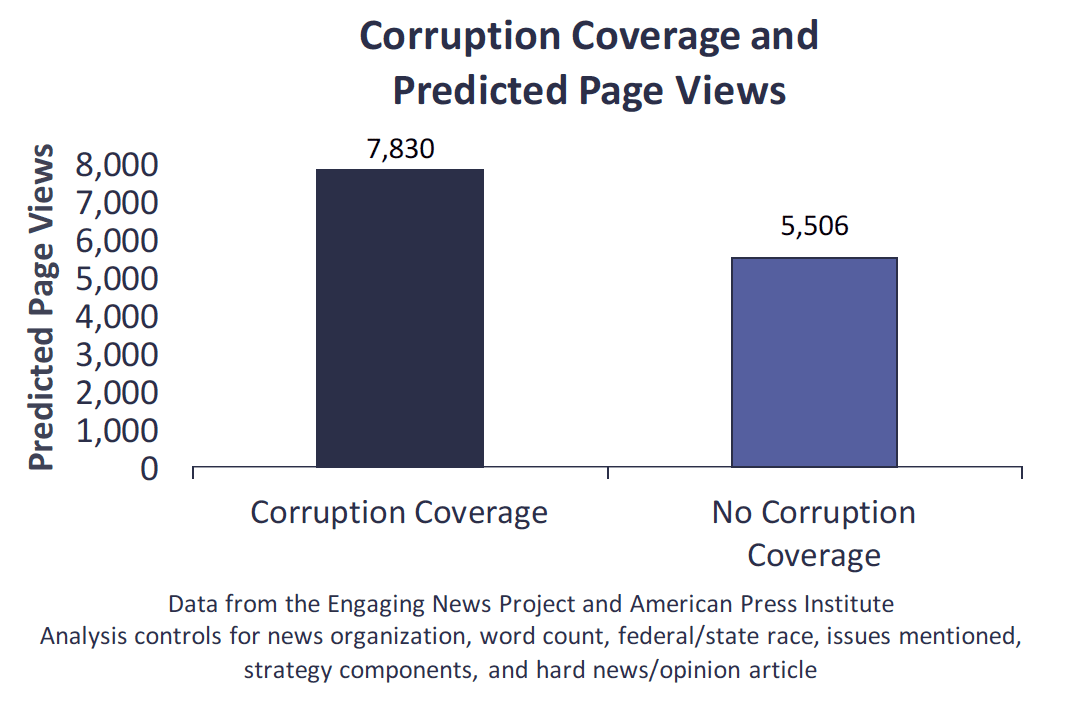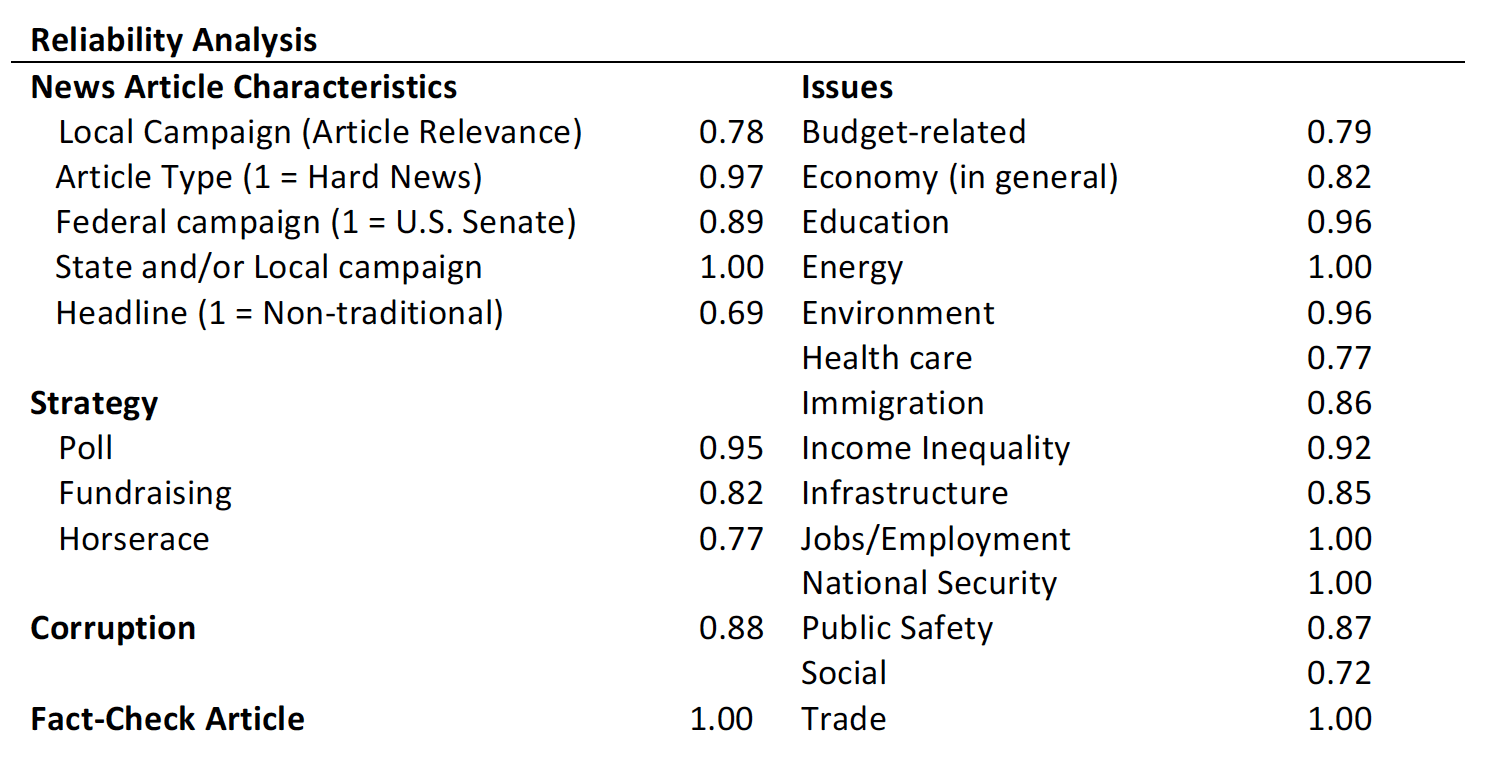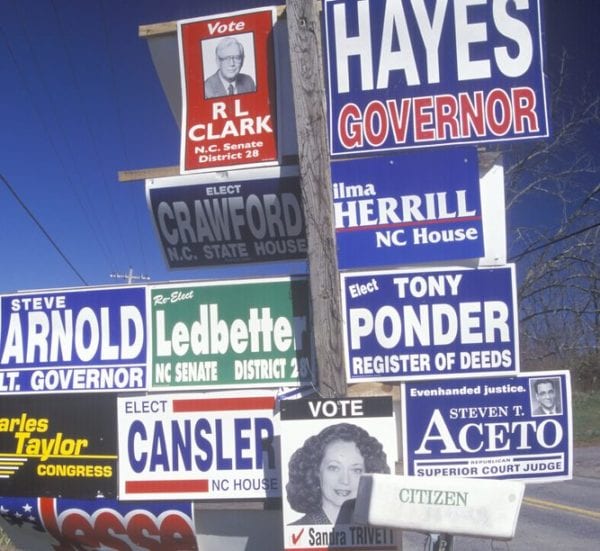
As Election Day approaches, more people seek news and information about politics. To understand the habits of news audiences in the run-up to the election, we analyzed what was being covered in reporting about down-ballot, non-presidential races for U.S. Congress, governor, and local offices in the lead-up to the 2016 general election. The results shared in this white paper suggest a tough spot for news organizations. Issue coverage is often heralded for helping to inform the public, yet the results show that the more issues covered in a news article, the lower the page views and social referrals. Issue coverage also declined in volume as the election approached, right when many prospective voters tuned in. The results do provide some insight into when issue coverage worked, however. Articles discussing social issues and corruption – two highly salient issues during the campaign – saw increased traffic.
This report, prepared as a collaboration between the Center for Media Engagement and the American Press Institute (API) and funded by the Democracy Fund, looks at local news coverage of the 2016 general election and what kinds of campaign coverage may have encouraged engagement with election news. We examined local news coverage by nine newspapers across six states.
The Center for Media Engagement categorized 705 general election-related newspaper stories that referenced a non-presidential campaign from the websites of the nine news outlets, tracking mentions of issues, campaign strategy, and fact-checking, among other campaign coverage characteristics. Where applicable, we compare these findings to an analysis of 435 primary election-related stories from an earlier report.
We correlated attributes of election news coverage with data from API’s Metrics for News (www.metricsfornews.com), an analytics tool that measures engagement in new ways and provides unique data-driven insights for publishers. The results offer an illustration of how people engage with various types of election news content.
Key Findings
Among this report’s findings:
- A third of local news stories about down-ballot campaigns referenced social issues.
- Economic topics like jobs and trade were not prominent on the local news agenda, despite their role in animating many of the voters who supported Donald Trump in the presidential election.
- The amount of issue coverage in local news declined as Election Day approached, a potential concern for undecided and late-deciding voters searching for candidate issue information.
- Coverage that focused on issues and strategy tended to receive fewer page views and social referrals than news articles that did not mention these aspects of the campaign.
- State and local campaign coverage drew audiences. A news article referencing a state or local political campaign garnered 46% more predicted page views and 87% more predicted social referrals than a news article covering a state or local race.
- A non-traditional, clickbait headline on a local news story reduced the predicted page views by 30% and predicted social referrals by 45%.
- News articles mentioning corruption earned more page views and social referrals.
- Fact-checking was rare in the local election news we analyzed.
Implications for Newsrooms
This report offers a glimpse of how nine local news outlets covered the last month of the 2016 election, and how audiences engaged with this content. We found that the national issues most important to the public during this time were not reflected in the issues covered in the local news. The number of issues news outlets covered declined as the election approached, a potential concern for undecided voters and those individuals arriving at decisions late in the process. Of the overall issue coverage that did exist, we find that more mentions led to fewer page views and social referrals. The news content that did engage voters, including mentions of state and/or local campaigns, social issues, and corruption, suggests that highly salient, local issues and campaigns can resonate with news users.
The Study
Social Issues Top the News Agenda; Jobs and Trade Lack News Emphasis
We evaluated whether each of the 705 election-related local news articles included any of 14 different issues. Almost three-quarters of the news stories (73%) mentioned at least one issue. Across the news articles examined, 33% mentioned three or more issues.
National survey data released just prior to the election showed that the economy topped the public’s list of the most important problem facing the country.1 Across the newspapers that we examined, economic issues were covered less frequently than social and public safety issues. This could indicate that other issues were atop voters’ minds in down-ballot races. Alternatively, it could signal a disconnect between coverage and the electorate’s issue priorities.
As seen in the chart below, the top issue referenced was social matters (35% of news stories), which included mentions of abortion and rights for women, LGBTQ individuals, and other historically marginalized groups. The next most frequently mentioned issue was public safety (32%), including gun control, crime, and emergency response. Taxes and budgetary issues were the next most emphasized issue (23%). Trade was the least frequently discussed issue (5%).
Examining the coverage, local news outlets’ coverage of social issues seemed to be influenced by what occurred at the top of the ballot with the presidential race. Coverage of then-candidate Donald Trump’s treatment of women—including the disclosure of the Access Hollywood tape—became an issue for Republican candidates down the ballot. News articles mentioning U.S. House and Senate races discussed how candidates for these offices were responding to the Trump tape and their positions on issues of women’s rights and sexual harassment. The national conversation became a prominent topic of debate down the ballot.
Issue Coverage Declines as General Election Approaches
The average local news article contained just over two issue mentions, though that number declined as the general election approached. On average, a news story published 20 to 32 days prior to the election had 2.5 issue mentions compared to 1.8 issue mentions in news stories published zero to nine days before Election Day. This change over time is statistically significant.2 A similar trend was found in coverage of the 2016 primary election by these news outlets.
Greater Issue Coverage Can Reduce Article Engagement
We examined how issue mentions in local election news stories influenced article engagement metrics, specifically page views, social referrals, and average read time. The number of issue mentions in an article affected the page views and social referrals a news story received, but not the average read time.3
As the number of issue mentions in an article increased, the predicted number of page views declined. An article containing three issue mentions had approximately 1,300 fewer page views compared to a local news story with no issue mentions.
A similar pattern describes the relationship between the number of issue mentions and predicted social referrals. As more issues were mentioned in a news story, the predicted number of social referrals to the article decreased. A news story with no issue mentions had approximately 200 more predicted social referrals compared to a news article with three issue mentions.
We analyzed whether articles mentioning one of the top issues in the coverage (social matters, public safety, budgets, and infrastructure) were any more successful in terms of article engagement—page views, average read time, or social referrals. We found that:
- Articles referencing social issues garnered significantly more page views and social referrals. One potential driver for this effect could have been the discussion of Donald Trump and the Access Hollywood tape during the time period we analyzed.
- News stories mentioning public safety matters garnered significantly fewer page views and social referrals.
- Budgetary and infrastructure matters did not influence any engagement metrics.4
State and Local Campaign Coverage Engages Audiences
More than half (53%) of the local news articles about non-presidential campaigns mentioned a state and/or local political campaign.
Non-federal campaign coverage is a draw for audiences.5 News articles mentioning state and local campaigns significantly increased the number of page views and social referrals associated with the story. A news article referencing a state or local political campaign garnered 1,800 more predicted page views and almost 300 more predicted social referrals compared to a news article not referencing a state or local campaign.
Local News Focuses on the ‘Horserace’ as Part of Strategy Coverage
Local news stories regarding the 2016 general election focused heavily on the elements of campaign strategy, including references to public opinion polls, campaign fundraising or spending, or the horserace diagnostic of who is winning. Two-thirds of the articles examined (66%) contained at least one mention of campaign strategy. On average, each election news story contained one strategy mention.
The horserace depiction of a campaign—which candidate is the “frontrunner” or “underdog”—was found in more than half of the news stories (54%). References to campaign fundraising and/or spending appeared in a third of news stories (34%) while public opinion polling information was referenced in almost a quarter (23%) of articles.
Greater Strategy Coverage Can Reduce Page Views and Social Referrals
The amount of strategy coverage—polling, fundraising, and horserace mentions—corresponds with news article engagement.6 As strategy coverage increases, the predicted number of page views and social referrals decline.
A local news story containing all three strategy components had 2,800 fewer predicted page views compared to election content containing no strategy mentions. Strategy coverage had a similar effect on the social referrals a local news article received.
The inclusion of an additional strategy mention in an article reduces the predicted social referrals to that article by approximately 100 referrals.
Clickbait Headlines Reduce Page Views and Social Referrals
News outlets have experimented with different types of headlines designed to entice online visitors into clicking and reading news stories. One such headline style, sometimes called “clickbait,” creates uncertainty about the news details to lure readers to click. We examined whether these types of clickbait headlines, found in about 10% of the local news stories coded in this study, influenced article engagement metrics.7
Clickbait headlines reduced the number of predicted page views a news story received. We found a negative influence of these non-traditional headlines on social referrals as well. A clickbait-style headline reduced the predicted page views by 2,000 and predicted social referrals by more than 250.
These findings for both the 2016 primary and general elections show that clickbait-oriented headlines can backfire in some contexts. Designed to increase reader engagement, clickbait can accomplish the opposite according to findings across 2016 local election news coverage.
Scandal Coverage Can Yield More Page Views and Social Referrals
Scandal and corruption were features of news coverage of non-presidential races; 22% of articles focused on accusations, investigations, or criminal charges leveled against non-presidential candidates for federal, state, or local office.
News articles mentioning corruption earned more page views and social referrals than articles not referencing scandal.8 A news article mentioning campaign or governmental corruption could expect to see 2,000 more predicted page views compared to an article not referencing corruption. Similarly, a news story referencing corruption earned double the social referrals (1,115) than a story not mentioning corruption did (574).
Fact-Checking Continues to be Rare Down the Ballot
Local news coverage of the 2016 election rarely included journalists evaluating the claims made by political campaigns, either in the primary or the general election. Only 2% of the articles examined included fact-checks of campaign advertisements or candidate claims. There were no meaningful differences in page views, social referrals, or average read time for the small number of news stories that featured fact-checking compared to news articles without fact-checking.9
Methodology
We examined 705 news stories from the websites of nine local newspapers across six states (California, Florida, Idaho, Pennsylvania, Texas, and Washington). Only news articles focusing on 2016 non- presidential election campaigns, including federal (U.S. Senate, U.S. House), statewide (e.g. gubernatorial, Attorney General, Supreme Court, etc.), and local races (e.g. mayor, council, supervisors, school board, etc.), were analyzed as part of this project. We excluded articles on ballot and referenda campaigns, and articles about the presidential election. For each news outlet, we examined articles that were published in the month prior to the general election. The unit of analysis was each article.
We coded the characteristics of each news article:
- Relevance: We coded whether news stories flagged as “political” by each newsroom in the Metrics for News platform were relevant to the purposes of this project by mentioning down-ballot political campaigns. Of 3,240 total stories that had anything to do with government or officials, 705 were relevant to non-presidential elections (22%) and used for further analysis.
- Type: We coded whether the article reported hard news (78%) or integrated opinion (22%) in some manner (e.g. editorial, blog commentary, letter to the editor).10
- Campaign type: We coded whether the article referenced a federal (54%) and/or state and local (53%) non-presidential campaign.
- Headline: We coded whether the article had a more traditional, summary headline (88.5%) or a clickbait-oriented headline (11.5%).
- Fact-check: We coded whether the news article was structured as a fact-check, including offering campaign claims with a subsequent journalist evaluation of the claims (2%).
- Corruption: We coded the extent to which a news article discussed government or campaign-related corruption, including scandal, criminal charges or accusations, or investigations (22%).
- Strategy coverage: We next examined the political strategy-related content in the news article, including whether public opinion/polling information (23%), fundraising or campaign spending information (34%), or horserace references (e.g. “favorite,” “frontrunner,” “underdog,” “sure loser,” “too close to call;” 54%) were present. For some of the analyses described, we combined these references into one additive measure for political strategy (M = 1.10, SD = 0.97, Range = 0 to 3).
- Issue mentions: We coded for mentions of budgetary matters (23%), the economy in general (12%), education (17%), energy (5%), the environment (16%), health care (17%), immigration (11%), income inequality and wages (9%), infrastructure and transportation (18%), international trade (5%), jobs and unemployment (11%), national security (9%), public safety (32%), and social issues including abortion, LGBTQ rights, women’s issues, and drugs (35%). For some of the analyses described, we combined these mentions into one additive measure for issue mentions (M = 18, SD = 2.21, Range = 0 to 11).
Before coding, we conducted a reliability analysis on a sample of at least 10% of the total news stories to ensure that the team of four coders was correctly identifying campaign news features. We used Krippendorff’s alpha as a measure of reliability, where scores above 0.67 are considered acceptable. Results of our analysis can be found below.
SUGGESTED CITATION:
Scacco, Joshua, Potts, Lauren, Hearit, Lauren, Sonderman, Jeff, and Stroud, Natalie Jomini. (2017, April). General election news coverage: what engages audiences down the ballot. Center for Media Engagement. https://mediaengagement.org/research/general-election-news-coverage-what-engages-audiences-down-the-ballot
- Auter, Z. (2016, October 14). “Americans continue to cite the economy as top problem.” Gallup. Retrieved from http://www.gallup.com/poll/196430/americans-continue-cite-economy-top-problem.aspx [↩]
- The number of issues mentioned differed significantly over time, F(2,702)=6.48, p<.01. A Games-Howell post hoc comparison reveals that the average number of issues mentioned zero to nine days (M=1.80) and 10 to 19 days prior to the election (M=2.36) differed significantly (p<.05). The average number of issues mentioned zero to nine days (M=1.80) and 20 to 32 days (M=2.45) prior to the election differed significantly (p<.01). There were no significant differences between issue mentions 10 to 19 days and 20 to 32 days prior to the election (p=.96). These results are affirmed when the number of issue mentions are regressed in two negative binomial regression models with controls for the news outlet, article word count, type of article, campaign race type, strategy mentions, and a continuous or ordinal-level (1, 2, 3) treatment of the time variable. [↩]
- In three separate regression models predicting the number of page views, average time on page with a news story, and social referrals (with controls for the news outlet, article word count, type of article, campaign race type, headline type, and strategy mentions), the number of issue mentions significantly reduces the number of page views (B=-.07 SE=.03; p<.01) and social referrals (B=-.11 SE=.04; p<.01). Issue references in local news articles do not influence average read time (B=1.89 SE=1.52; p=.22). The dependent variables – page views and social referrals – were modeled using negative binomial regression. Average read time was modeled using OLS regression. [↩]
- In three separate regression models predicting the number of page views, average time on page with a news story, and social referrals (with controls for the news outlet, article word count, type of article, campaign race type, headline type, and strategy mentions), mentions of social issues significantly increase the number of page views (B=.50 SE=.13; p<.01) and social referrals (B=.73 SE=.18; p<.01). Conversely, references to public safety matters significantly reduce the number of page views (B=-.47 SE=.13; p<.01) and social referrals (B=-.58 SE=.18; p<.01). Coverage of infrastructure has a marginally significant influence on reducing page views (B=-.29 SE=.15; p=.06) and social referrals (B=-.38 SE=.22; p=.08). None of the top issues referenced in the local news articles influenced average read time. The dependent variables – page views and social referrals – were modeled using negative binomial regression. Average read time was modeled using OLS regression. [↩]
- In three separate regression models predicting the number of page views, average time on page with a news story, and social referrals (with controls for the news outlet, article word count, type of article, headline type, issue references, and strategy mentions), mentions of state and local political campaigns increase page views (B=.38 SE=.13; p<.01) and social referrals (B=.63 SE=.18; p<.01). Mentions of state and local campaigns have no effect on average read time for an article (B=7.13, SE=5.50; p=.20). The dependent variables – page views and social referrals – were modeled using negative binomial regression. Average read time was modeled using OLS regression. [↩]
- In three separate regression models predicting the number of page views, average time on page with a news story, and social referrals (with controls for the news outlet, article word count, type of article, campaign race type, headline type, and issue mentions), strategy mentions significantly reduce the number of page views (B=-.17 SE=.07; p=.01) and social referrals (B=-.20 SE=.10; p<.05). Strategy references did not influence average read time (B=-2.21 SE=3.39; p=.52). The dependent variables – page views and social referrals – were modeled using negative binomial regression. Average read time was modeled using OLS regression. [↩]
- In three separate regression models predicting the number of page views, average time on page with a news story, and social referrals (with controls for the news outlet, article word count, type of article, campaign race type, strategy and issue mentions), non-traditional headlines significantly reduce the number of page views (B=-.36 SE=.17; p<.05) and social referrals (B=-.59 SE=.24; p<.05). The type of headline did not influence average read time (B=2.36 SE=9.23; p=.80). The dependent variables – page views and social referrals – were modeled using negative binomial regression. Average read time was modeled using OLS regression. [↩]
- In three separate regression models predicting the number of page views, average time on page with a news story, and social referrals (with controls for the news outlet, article word count, type of article, campaign race type, headline type, strategy and issue mentions), mentions of corruption significantly increase the number of page views (B=.35 SE=.16; p<.05) and social referrals (B=.66 SE=.22; p<.01). We note that when corruption is added to the model, campaign strategy mentions have only a marginally significant effect on social referrals (B=-.16 SE=.09; p<.10). Corruption references did not influence average read time. The dependent variables – page views and social referrals – were modeled using negative binomial regression. Average read time was modeled using OLS regression. [↩]
- In three separate regression models predicting the number of page views, average time on page with a news story, and social referrals (with controls for the news outlet, article word count, type of article, campaign race type, headline type, strategy and issue mentions), fact-check structured articles had no influence on the number of page views (B=-.32 SE=.43; p=.46), social referrals (B=-.49 SE=.59; p=.40), or read time (B=.53 SE=21.46; p=.98). The dependent variables – page views and social referrals – were modeled using negative binomial regression. Average read time was modeled using OLS regression. [↩]
- We include the type of news article as a control in our regression analyses of story page views, average time on page, and social referrals. In no instance is the type of article a statistically significant factor for article engagement. [↩]





